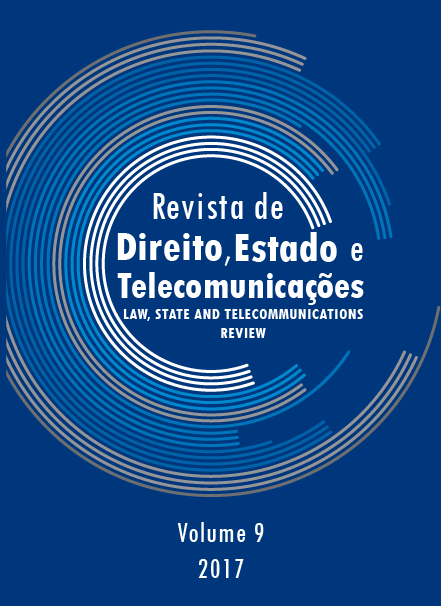Regulation of Telecommunications: The Choice Between Market and Regulatory Failures
DOI:
https://doi.org/10.26512/lstr.v9i1.21511Palabras clave:
Liberalization. Market failure. Regulatory failure. Telecommunications. Competition.Resumen
Purpose ”“ The paper examines the main regulatory frameworks of the telecommunications industry through the concept of market failure and analyses how and why the policy often leads to undesirable outcomes that might be considered as regulatory failure.
Methodology/approach/design ”“ The research uses the EU regulatory framework for electronic communications as a base for the analysis of the main policy objectives through the prism of the market failure theory with an eye to the interests of the main market players in the telecommunications markets.
Findings ”“ About any aspect of regulation allows to find ways to create opportunities for some groups of the industry and stifle activity of others. Despite the theory of market failure provides reasonable justifications for regulation of telecommunications markets, it is possible to argue that many of these problems are mainly the consequence of the policy and could be better solved by market mechanisms.
Originality/value ”“ The results of the research allow to look at the problems of telecommunications development and issues of the high level of concentration of the telecommunications markets as regulatory formed problems rather than consequences of the inherited industry’s characteristics.
Descargas
Citas
Bloch,H.,G. Madden,& S. Savage(2001).“Economies of Scale and Scope in AustralianTelecommunications”,Review of Industrial Organization, 18(2):219-227.
Buchanan, J.M., & G.Tullock(1962).The Calculus of Consent: Logical Foundations of Constitutional Democracy. AnnArbor: University of Michigan Press.
Clifton,J., D. Díaz-Fuentes, & J. Revuelta(2010)."The political economy of telecoms and electricity internationalization in the single market", Journal of European Public Policy, 17(7):988-1006.
Canoy ,M., de Bijl, P., & R. Kemp(2003).“Access to Telecommunications Networks”, TILEC Discussion Papers, No. DP2003-07.
Coase, R. (1959).“The Federal Communications Commission”, Journal of Law and Economics, 2:1”“40.
Compaine, B(2003). “Revisiting Cost and Affordability Assumptions for High Speed Data Services in Low Population Density Locations”, Telecommunications Policy Research Conference.
De Bijl, P(2005). “Structural Separation and Access in Telecommunications Markets”, CESifo Working Paper, No.1554.
Dempsey, P. S(1989). “Market Failure and Regulatory Failure as Catalysts for Political Change: the Choice Between Imperfect Regulation and Imperfect Competition”, Wash. & LeeL. Rev., 46(1):1-40.
FTTH Council Europe(2012). Creating a brighter future. Fiber to the home: Taking your life to new horizons! Press conference - BBWF Amsterdam, 16 October 2012. Available at: http://www.ftthcouncil.eu/documents/Presentations/20121016PressConfBBWF.pdf.
Grande, E.(1994).“The New Role of the State in Telecommunications: an International Comparison”, West European Politics, 17(3):138”“157.
Grove, A(2003). “Churning Things Up Innovations with the power to transform entire industries are the Holy Grail of business strategy. Unfortunately, the innovators don't always survive.” FORTUNE Magazine, August 11, Available at: http://archive.fortune.com/magazines/fortune/fortune_archive/2003/08/11/346796/index.htm.
Hochheiser, S.(1990). “The American Telephone and Telegraph Company (AT&T)” in: Fritz Froehlich(ed.), The Encyclopedia of Telecommunications, vol. 1. New York: Marcel DekkerInc.
Holcombe, R. G.(2015).Political capitalism. Cato Journal, 35(1):41-66.
Joskow, P. L. ,& N. L. Rose(1987). “The Effects of Economic Regulation”, Working Paper, Department of Economics, MIT, No447.
Katz,M. L., & C. Shapiro(1985).“Network Externalities,C Competition, and Compatibility”, American Economic Review,75(3):424”“440.
Koenig,C.,Bartosch,A.,&J.D.Braun(2002).EC Competition and Telecommunications Law: A Practitioner’s Guide. Kluwer Law International.
Lemstra, W., & Melody, W. H., Eds.(2014). The Dynamics of Broadband Markets in Europe”“Realizing the2020 Digital Agenda. Cambridge, UK: Cambridge University Press.
Lessig, L.(2001). The Future of Ideas: The Fate o of the Commons in a Connected World. NewYork: RandomHouse.
Lessig, L.(2007). “Internet Policy: Deregulating Spectrum. ”http://www.lessig.org/2007/02/internet-policy-deregulating-s/.
Mazzucato, M., & Penna, C. C. (2016). “Beyond market failures: The market creating and shaping roles of stateinvestment banks”, Journal of Economic Policy Reform, 19(4):305-326.
Melody, W. H.(2012).“View point: The Closing of the Liberalization Era in European Telecommunication”. Competition & Reg. Network Indus,13,218-235.
Mills,E.S.(1986).Burden of Government. Hoover Press.
Mueller, M. L.(2010). Networks and states: The global politics of Internet governance. MITpress.
Murphy,R. H.(2015). “The Impact of Economic Inequality on Economic Freedom”, Cato Journal, 35(1):117-131.
Noam, E. M.(1992). Telecommunications in Europe. New York: Oxford University Press.
OECD(2015).OECD Digital Economy Outlook 2015.
Rood, H.(2010). “Very HighSpeed Broadb and Deployment in Europe:The Netherlands and Bulgaria Compared”,Telecom Policy Research Conference, Arlington, VA: TPRC.
Posner,R.(1979). “The Chicago School of Antitrust Analysis”,University of Pennsylvania Law Review, 127(4):925”“948.
Rose-Ackerman, S.(1978). Corruption: a Study in Political Economy.New York: Academic Press.
Serdarevic´, G., Hunt, M., Ovington, T., & Kenny, C.(2016).“Evidence for a Ladder of Investment in Central and Eastern European Countries”,Telecommunications Policy, 40:515-531.
Spulber, D. F., & Yoo, C. S.(2014). “Antitrust, the Internet,and the Economics of Networks”. In: R.D.Blair and D.D.Sokoleds. Oxford Handbook of International Antitrust Economics, Oxford University Press. Available at SSRN:https://ssrn.com/abstract=2370050.
Staple, G., & K. Werbach(2004).“The End of Spectrum Scarcity”, IEEE Spectrum, 41(3):48”“52.
Stigler, G. J.(1971).“TheTheory of Economic Regulation”, The Bell Journal of Economics and Management Science, 2(1):3”“21.
Stiglitz, J. E.(1988).Economics of the Public Sector.WWNorton & Company.
Trubnikov, D.(2017).“Analysing the Impact of Regulation on Disruptive Innovations:The Case of Wireless Technology”. Journal of Industry, Competition and Trade, 1-22.doi:10.1007/s10842-016-0243-y.
Tversky, A., & D. Kahneman(1974).“Judgment Under Uncertainty: Heuristics and Biases”,S cience, 185(4157):1124”“1131.
Vodafone Group(2015). Vodafone and Europe: Investing for the Future.Vodafone GroupPlc.
Wanichkorn, K., & Sirbu, M.(2002).“The Role of Fixed Wireless Access Networks in the Deployment of Broadband Services and Competition in Local Telecommunications Markets”.Telecommunications Policy Research Conference.
Werbach, K(2004). Radio Revolution: The Coming Age of Unlicensed Wireless. New America Foundation.
Yoo, C. S.(2014).“US vs. European Broadband Deployment: What Do the Data Say?”UofPenn, InstforLaw & EconResearch Paper.No.14-35. AvailableatSSRN:http://ssrn.com/abstract=2510854.
Descargas
Publicado
Cómo citar
Número
Sección
Licencia
Al enviar este documento a la Revista de Derecho, Estado y Telecomunicaciones,
declaro que estoy aceptando los términos de Creative Commons Attribution 4.0 International (CC BY 4.0)


